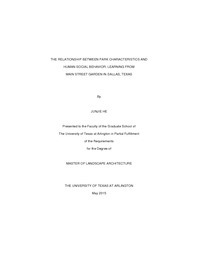
ATTENTION: The works hosted here are being migrated to a new repository that will consolidate resources, improve discoverability, and better show UTA's research impact on the global community. We will update authors as the migration progresses. Please see MavMatrix for more information.
Show simple item record
| dc.contributor.author | He, Junjie | en_US |
| dc.date.accessioned | 2015-07-31T22:10:19Z | |
| dc.date.available | 2015-07-31T22:10:19Z | |
| dc.date.submitted | January 2015 | en_US |
| dc.identifier.other | DISS-13179 | en_US |
| dc.identifier.uri | http://hdl.handle.net/10106/25117 | |
| dc.description.abstract | The objective of this thesis is to study the relationship between park characteristics and human social behavior in Main Street Garden Park in Dallas. Whyte highlights several characteristics that promote the successful use of urban spaces: sitting space, nature, concessions, pathways, and triangulation (Whyte 1980). The ways in which these five characteristics influence human social behavior is the focus of this thesis. The aspects of human social behavior studied in this thesis are the proportions of couples, women, children, and pet-owners; usage times; self-congestion, meaning the amount and location of new interaction; and individualism. Using Main Street Garden in downtown Dallas as a case study, the thesis uses on-site observations and interviews with park users and landscape designers to analyze how park characteristics affect human social behavior. Park environments are increasingly recognized as influential settings in the built environment that have potential to change human behavior. A great deal of research focuses on how park size, location, aesthetics, and conditions correlate with health benefits and economic benefits (Bedimo-Rung et al. 2011; Bruton 2013; Lynnette 2007). In contrast, relatively little research has been conducted on the relationship between specific park features and human social behaviors. In response to these gaps in the literature, this research investigates characteristics of Main Street Garden to determine how these factors influence human social behavior. Main Street Garden has been chosen based on its function as a community gathering space for Dallas and its connectivity to the downtown area. This research uses qualitative techniques (Taylor and Bogdan 1984) in the form of the researcher's passive on-site observations to analyze park characteristics. Visual design factors and park characteristics, including defined space, trees, sitting space, triangulation, water features, food concessions, pathways, and the relationship to the street, are recorded in photographs. This research also utilizes in-depth interviews with visitors to the park and designers to obtain a rich understanding of the users' experiences and perspectives (Taylor and Bogdan 1984). Also, the researcher uses the process of snowball sampling (Goodman 1961). After interviewing the first designer informant, the researcher asks for assistance to help identify other park designers and planners in the Dallas Fort Worth (DFW) area. Data analysis and findings from this research illustrate how various park characteristics and design features play an important role in people's social behavior in Main Street Garden in Dallas. Key words are identified to describe the primary themes from the interview data. Themes are developed from both the observation and interview data from Main Street Garden. The themes in this research identify which park characteristics can affect human social behavior and discuss how they affect them. When designing and planning future urban parks, these characteristics and features can be implemented to enhance the aspects of human social behavior studied in this thesis. | en_US |
| dc.description.sponsorship | Richards, James P. | en_US |
| dc.language.iso | en | en_US |
| dc.publisher | Landscape Architecture | en_US |
| dc.title | The Relationship Between Park Characteristics And Human Social Behavior: Learning From Main Street Garden In Dallas, Texas | en_US |
| dc.type | M.L.A. | en_US |
| dc.contributor.committeeChair | Richards, James P. | en_US |
| dc.degree.department | Landscape Architecture | en_US |
| dc.degree.discipline | Landscape Architecture | en_US |
| dc.degree.grantor | University of Texas at Arlington | en_US |
| dc.degree.level | masters | en_US |
| dc.degree.name | M.L.A. | en_US |
Files in this item
- Name:
- He_uta_2502M_13179.pdf
- Size:
- 2.774Mb
- Format:
- PDF
This item appears in the following Collection(s)
Show simple item record


